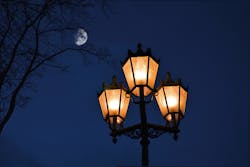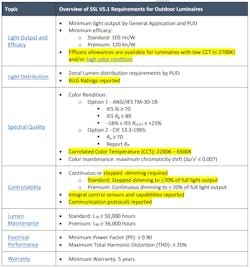DLC launches LUNA outdoor SSL program, publishes draft requirements (UPDATED)
The DesignLights Consortium (DLC) has launched the LUNA (Light Usage for Night Applications) program along with a V1.0 draft requirements document that will ultimately gate the organization’s QPL (Qualified Products List) for outdoor solid-state lighting (SSL) fixtures. Comments on the draft are due May 21, 2021. The LUNA specification builds on the DLC SSL V5.1 specification adding requirements that minimize light pollution and sky glow while optimizing visibility and comfort for humans outdoors at night.
Back in March, the DLC revealed the LUNA concept and announced the LUNA Advisory Group. The group includes Pete Strasser of the IDA (International Dark-Sky Association); Terry McGowan of Lighting Ideas; Naomi Miller of PNNL (Pacific Northwest National Laboratory); Gayathri Unnikrishan of the International WELL Building Institute; Alex Baker of the IES (Illuminating Engineering Society); Kevin Fitzmaurice of Georgia Power; and Jim Benya of Benya Burnett Consultants. That group will work with DLC staff to guide the program with the first deliverable the supplemental LUNA requirements draft.
“Light pollution in the form of sky glow, light trespass, and glare has been associated with a number of adverse impacts that affect people and wildlife and contribute to unnecessary energy costs and carbon emissions,” said DLC executive director and CEO Christina Halfpenny. “As the DLC continues to emphasize quality of light aspects of products on our Qualified Products List, we look forward to insights and feedback from the LUNA Advisory Group as we explore the development of a supplemental specification aimed at mitigating the negative impacts of artificial light at night.”
While the LUNA requirements draft is described as a supplemental specification to DLC SSL V5.1, the document still stretches to 27 pages. It defines categories of outdoor products in the form of primary use designations covered by the specification. But the summary of the requirements fit neatly in Table 2 of the requirements draft. The draft requires 105-lm/W efficacy for standard QPL listing and 120 lm/W for premium listing. The specification will allow efficacy allowances for CCT below 2700K and for high color-rendering performance or what the DLC calls spectral quality.
In this table from the DLC's SSL V5.1 Requirements for Outdoor Luminaires, entries highlighted in yellow represent areas that would be overruled by the proposed LUNA specifications. You can see the draft of the LUNA technical requirements at https://bit.ly/3a9yZVC. (Table credit: Image courtesy of the DesignLights Consortium.)
The specification specifies basically no uplight characterized by the IES BUG (backlight, uplight, and glare) rating. Moreover, manufacturers are encouraged to use shielding to prevent light trespass and can even get an efficacy allowance for such shielding. In terms of glare, the LUNA group will participate in industry efforts to develop better glare metrics with those being added into future revisions of the requirements.
The specification will require networked lighting controls (NLCs) and mandates minimum dimming requirements. It does not specify a network protocol but requires manufacturers to detail the protocol used in their products. A premium listing will require continuous dimming to 20% of full output.
The DLC will hold a webinar on April 28 to discuss the draft. The organization hopes to deliver a second and near final draft of the specification in July. If all goes according to plan, the final policy will be released in October.
The industry night lighting practices have changed considerably in the past few years. Early LED street and area lights used cooler CCTs for maximum energy savings. And there is some evidence that visual acuity is better under such lights. But more people prefer warmer CCTs. The warmer lighting is apparently better tolerated by wildlife. And sky glow is decreased. Still, the industry must also address safety, which is why we use outdoor lighting in so many places in the typical municipality.
We also published an article recently that contemplated the extent to which street and area lighting impacted uplight as seen from space. The transition to LED sources means that most outdoor lighting these days is focused downward. And signs, façades, lit windows, and more are perhaps more responsible for uplight. Still, the DLC document will be a welcome tool for designers/specifiers, municipalities, utilities, manufacturers, and more.
More like this
Think Tank to London: Improve your lighting now
Embracing the dark side of lighting
LED and SSL technology must evolve in observatory-friendly manner
Prioritize photometrics in outdoor lighting retrofits
LEDs Magazine chief editor MAURY WRIGHT is an electronics engineer turned technology journalist, who has focused specifically on the LED & Lighting industry for the past decade.
*Updated Apr. 14, 2021 3:27 PM for addition of DLC table.
For up-to-the-minute LED and SSL updates, why not follow us on Twitter? You’ll find curated content and commentary, as well as information on industry events, webcasts, and surveys on our LinkedIn Company Page and our Facebook page.

Maury Wright | Editor in Chief
Maury Wright is an electronics engineer turned technology journalist, who has focused specifically on the LED & Lighting industry for the past decade. Wright first wrote for LEDs Magazine as a contractor in 2010, and took over as Editor-in-Chief in 2012. He has broad experience in technology areas ranging from microprocessors to digital media to wireless networks that he gained over 30 years in the trade press. Wright has experience running global editorial operations, such as during his tenure as worldwide editorial director of EDN Magazine, and has been instrumental in launching publication websites going back to the earliest days of the Internet. Wright has won numerous industry awards, including multiple ASBPE national awards for B2B journalism excellence, and has received finalist recognition for LEDs Magazine in the FOLIO Eddie Awards. He received a BS in electrical engineering from Auburn University.






![The DesignLights Consortium continues to make progress in shifting outdoor lighting products and implementation practices toward a more restrained and thoughtful strategy. [Image does not represent a DLC qualified fixture.] The DesignLights Consortium continues to make progress in shifting outdoor lighting products and implementation practices toward a more restrained and thoughtful strategy. [Image does not represent a DLC qualified fixture.]](https://img.ledsmagazine.com/files/base/ebm/leds/image/2024/08/66be810888ae93f656446f61-dreamstime_m_265700653.png?auto=format,compress&fit=&q=45&h=139&height=139&w=250&width=250)